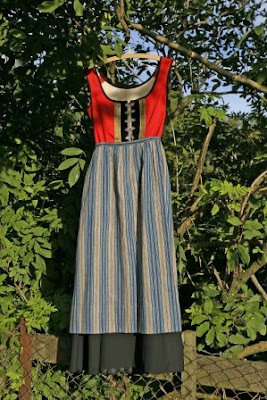Hello all,
Today I will continue to talk about the Icelandic costumes, specifically the type known as Upphlutur, or bodice costume. This was derived from the faldbúningur by the substitution of the high headdress by the stocking cap, the loss of the jacket, and general simplification of the costume. This became the everyday dress of Iceland. In each of the two images above, you see one example of each of the two variants, one of which was typical of the 19th cent, and the other of the 20th. Both are characterized by plain skirts, striped or plaid linen aprons, and white linen chemises or blouses. Here are two women in the 19th cent. Upphlutur.
Here is a schematic showing the salient points of this variation.
The stocking cap is large and stays on easily. The bodice is simple, with ribbons or small panels of embroidery to either side of the front opening. A silk kerchief was tied around the neck.
Skirts were usually black, but aprons are made in many colors.
One of the main points of this costume is that it made for ease of movement, it was easy to work in.
The back of the bodice was also ornamented with ribbons.
This costume has one again become popular, and is often seen.
In the 20th cent. the upphlutur underwent some changes. It became more dressy, and was no longer worn for everyday.
The cap became smaller, while the tassel became larger. This made it necessary to hold the cap on with pins. The bodice acquired filligree metal jewelry in place of the ribbon or embroidery on either side of the opening, and a belt with jewelry was once again worn. The blouse is sometimes dark, and the plaid apron may be made of silk. A neck kerchief is no longer worn with this variant.
Here we see a 20th cent upphlutur on the right, a rather transitional version on the left, and the faldbúningur in the center.
Some closeups of the metalwork on the bodice and belt.
The back of the bodice became somewhat simpler.
The new form of the cap is rather unwieldy, but is attractive enough if you can keep it on.
The upphlutur of either version is the costume most commonly worn by girls. Younger girls often wear a different cap.
This costume in either variant remains perhaps the most popular of the Icelandic costumes, and is widely worn still today.
Thank you for reading, I hope that you have found this interesting and perhaps inspiring.
Feel
free to contact me with requests for research. I hope to eventually
cover all of Europe and the Former Russian Empire/Soviet Union. I also
gratefully accept tips on source materials which i may not have. I also
accept commissions to research/design, sew, and/or embroider costumes
or other items for groups or individuals. I also choreograph and teach
folk dance.
Roman K.
email
A good article on the various types of buningur.
http://en.wikipedia.org/wiki/Icelandic_national_costume
Here is the Heimilisiðnaðarsafnið textile museum website
http://textile.is/
The Iceland national costume website. I have relied heavily on this site for information.
http://www.buningurinn.is/?i=2
Other sources:
Hildur Hermóðsdóttir, 'Icelandic National Costumes' Reykjavik, 2012
Elsa Gudjónsson, 'Traditional Icelandic Embroidery', Reykjavik, 1982
Charles Holme, 'Peasant art in Sweden, Lappland and Iceland', London, 1910
Roman K.










































Very interesting ... Thanks for your info
ReplyDeletePlease permit me download photo-photo ya ...
I make no claim to ownership of these images.
DeleteYou may download them without any problem.
Helpful info here. Please stay us updated like this. Thanks for sharing this
ReplyDeleteGreat site. Plenty of helpful information here. I am sending it to several buddies
ReplyDeleteWow that was unusual. Just wanted to say wonderful blog! Keep it up
ReplyDeleteThank goodness I found it. You’ve made my day! Thanks again for this information
ReplyDelete